Lespedeza Species in the Carolinas
by Bill Stringer*
Reprinted from the Spring 2011 Journal of the South Carolina Native Plant Society, and used by permission.
To see pictures or additional information about a particular plant, click its name.
The genus and species names of plants sometimes have interesting origins. Take the genus Lespedeza, for instance. It is derived from a mistaken reading of the name of an early Spanish governor of Florida — Senor Cespedez. Erroneous derivation notwithstanding, the honorable governor’s namesake genus contains some interesting species. The USDA Plants Database (https://plants.usda.gov/home) lists 36 entries for the continental US, a third of which occur in South Carolina. Most have lespedeza as a part of their common name, and some sources refer to them as bush clovers or prairie clovers.
The Lespedezas are members of the Fabaceae family (legumes). The most commonly seen Lespedeza species in the Carolinas are introduced, and these are all more or less invasive species:
Sericea lespedeza (L. cuneata) was widely planted in the past for soil conservation purposes, and is ubiquitous throughout the South.
Bicolor lespedeza (L. bicolor) is a shrubby species that has been widely planted for game bird habitat, and often forms a continuous shrub layer, to the exclusion of native species.Thunberg’s lespedeza (L. thunbergii) has been used to some degree for ornamental purposes, and does not appear as invasive as sericea and bicolor.
Figure 1.

Hairy lespedeza
Lespedeza hirta
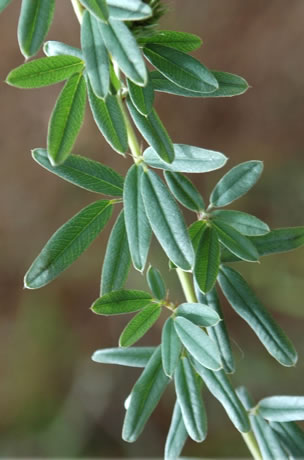
Round-headed lespedeza
Lespedeza capitata
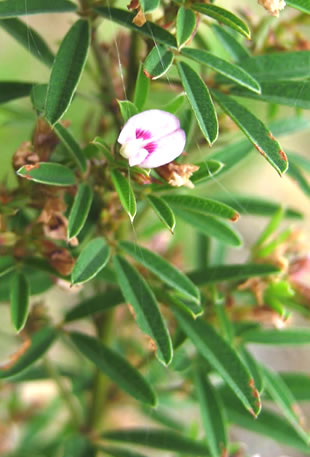
Slender lespedeza
Lespedeza virginica
The native Lespedezas are an interesting group. They range in growth habit from sub-shrub to trailing or twiny.
Hairy lespedeza (L. hirta) is 2-4 ft tall, with multiple stems, oval-shaped hairy leaflets, and white flowers with purple centers closely clustered near the tip of each stem
(see http://namethatplant.net/plantdetail.shtml?plant=808).
Round-headed lespedeza (L. capitata) is similar in appearance, but with longer, narrower, silver-green leaves
(see http://missouriplants.com/Lespedeza_capitata_page.html).
Slender lespedeza (L. virginica) is 2 - 3 feet tall, with narrowly oblong leaves and pink flowers, usually found on the upper one-quarter of the stem.
(see http://
namethatplant.net/plantdetail.shtml?plant=1913).
Compare the leaves of these species in Figure 1.
Figure 2.

Sericea lespedeza
Lespedeza cuneata
Photo by James H. Miller,
USDA Forest Service
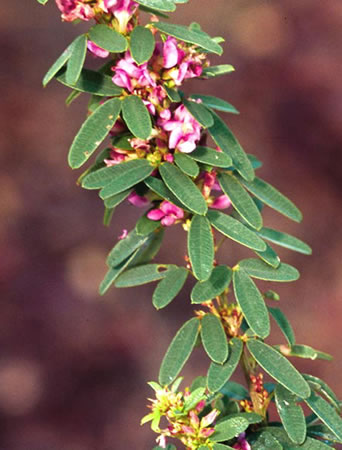
Slender lespedeza
Lespedeza virginica
Ted Bodner,
Southern Weed Science Society,
Bugwood.org
It can be hard to discriminate between the invasive sericea lespedeza and the native slender lespedeza (see Fig. 2). Sericea has white to pale violet flowers all along the stem, while slender has pink flowers on the upper part.
There are two low-growing Lespedezas found in the Carolinas:
Trailing lespedeza (Lespedeza procumbens) has upright branches growing from prostrate stems. Pink flowers are produced on the branch tips. A key identifying character is the hairy stems and branches.
Creeping lespedeza (L. repens) is similar in growth habit and appearance, but with no hair on the stems and branches
(see http://southeasternflora.com/view_flora.asp?plantid=55).
Two introduced short-growing annual species were once in the genus Lespedeza:
Korean lespedeza (L. stipulacea) and striate lespedeza (L. striata). Introduced as forage plants, they are no longer planted, but chances are very good that you can still find them in your lawn. These species have been moved to the genus Kummerowia.
Some Lespedezas are commonly confused with similar-looking Desmodium species, as both have trifoliate leaves. And, there are both prostrate and upright species in both genera. However, there a couple of dependable discriminating characters:
Figure 3.
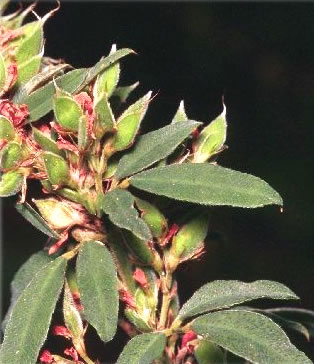
Lespedeza fruits (legumes)

Desmodium fruits (loments)
Desmodiums have stipels at the bases of the individual leaflets of a leaf (see definitions below), whereas Lespedezas don’t.
Also, the fruits of Lespedezas are borne singly, whereas Desmodium fruits are borne in long series of single fruits (loments) — see Figure 3. We all recognize these as the infamous “beggar ticks” that stick to our clothing at maturity.
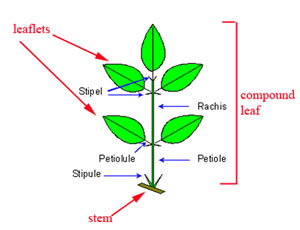
Definitions:
Stipule — A small leafy or spiny outgrowth at the base of a leaf or its petiole; usually occurring in pairs.
Stipel — Similar to stipules, except that they are found at the bases of the leaflets of a leaf. Found on compound leaves.
* Dr. Stringer is an Associate Professor Emeritus of Agronomy in the Department of Entomology, Soils and Plant Sciences, Clemson University, former State President and current Upstate Chapter President of the South Carolina Native Plant Society.

